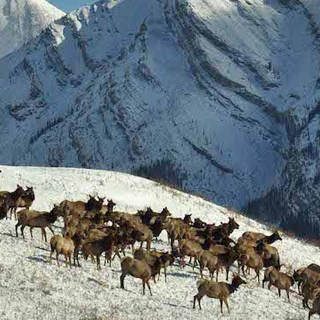Range Ecology
Montane grasslands play a key role in supporting wintering elk in the Rocky Mountains of Alberta. To document change in grassland extent and patch sizes, former student Lindsay Glines analyzed repeat aerial photography at four sites in the upper Red Deer River drainage between 1952 and 2003. Excluding the Ya Ha Tinda, grassland extent declined 52 + 20%, shrubland 39 + 41%, with an increase in mixedwood forest of 32%, and coniferous forest of 39 + 10%. The rate of grassland loss differed among sites: West Lakes > Tyrrell Flats ~ Scotch Camp.
Grassland area at Ya Ha Tinda was the same in 1952 and 2003 due to shrub mowing. Grassland patch size increased on average, but decreased in WL as larger patches of fragmented with woody plant encroachment. From 100-m transects along grassland-shrub-forest ecotones, differences in herbaceous biomass and species richness existed within cover types, but no pattern in edge effects on herbaceous biomass could be detected between ecotone type or among sites, except at the Ya Ha Tinda.
Former student Leslie McInenely examined montane rough fescue (Festuca campestris Rydb.) grasslands that were historically grazed in winter, but changes in migratory behavior of elk (Cervus elaphus) may lead to year-long grazing. She described spatio-temporal patterns in nutrient return on a fescue grassland at the Ya-Ha-Tinda ranch, responses of grassland plants and soils to seasonal defoliation, and fescue plant responses to nitrogen-form and defoliation. Elk pellet group distribution shifted seasonally and was associated with site productivity, rough fescue, topography, and vegetation cover. In a two-year field experiment, above-ground carbon and nitrogen pools at the community level responded to changes in seasonal defoliation while root biomass and soil N did not change. A greenhouse experiment showed that declines in rough fescue under high nitrogen availability and defoliation result from decreased tillering and root growth, not increased mortality.
